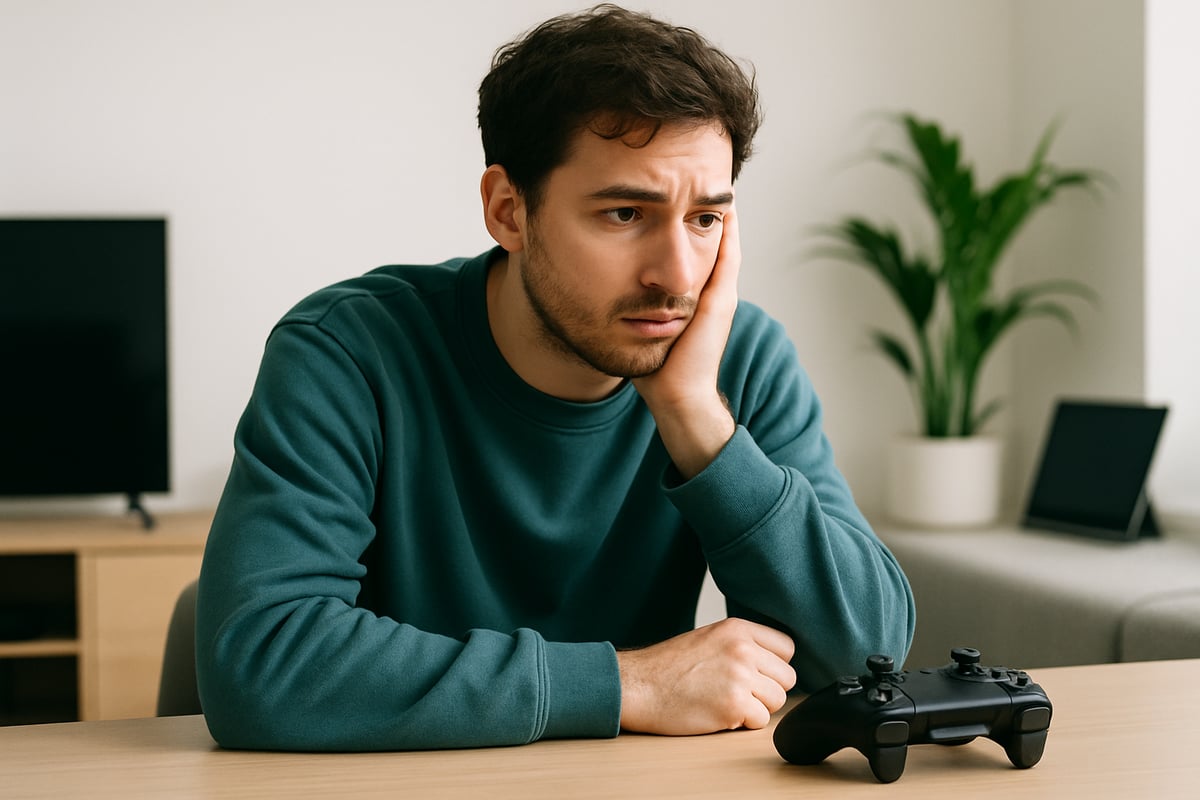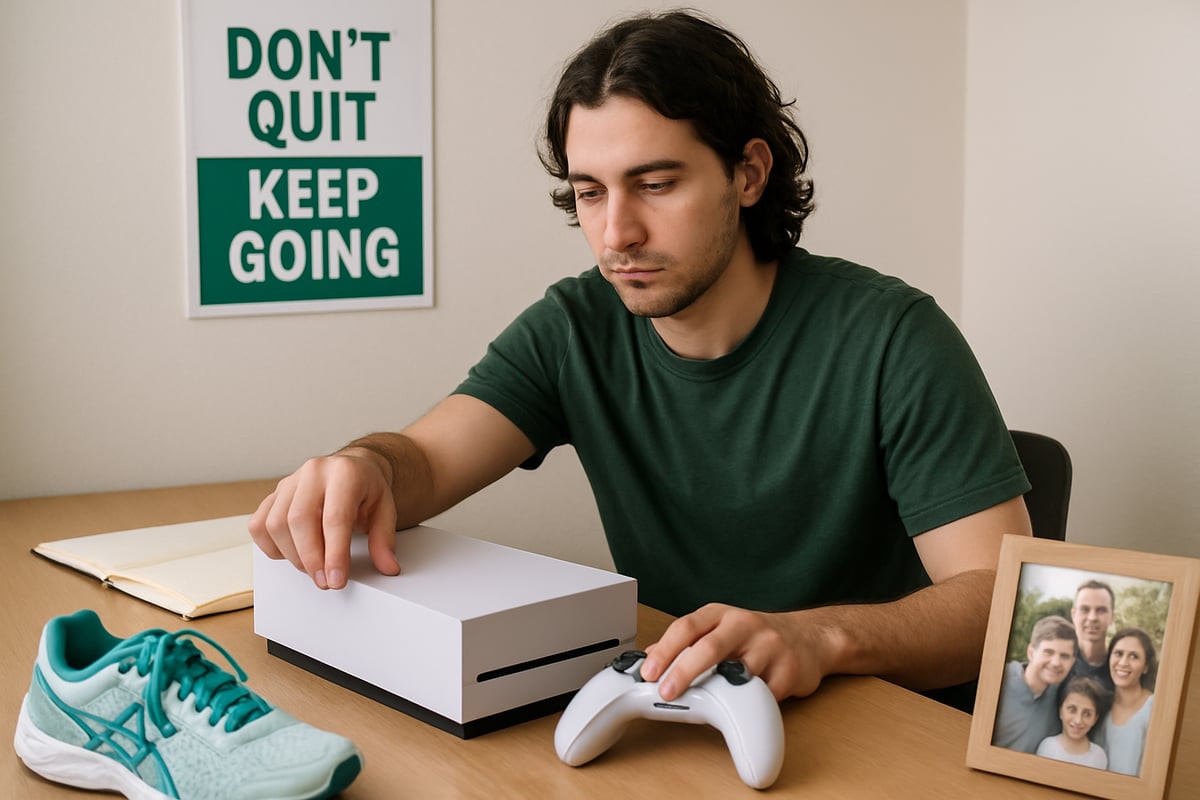The rise of video games has transformed entertainment worldwide, offering social connection, fun,...
Gaming Rehab Guide: Steps to Overcoming Game Addiction 2025
Struggling to put down the controller? You’re not alone. Gaming addiction is a rising concern in 2025, now impacting millions of individuals worldwide across all age groups.
This guide serves as your evidence-based roadmap for gaming rehab, designed to help you regain control, restore balance, and build a healthier relationship with gaming.
Inside, you’ll discover how to recognize addiction signs, understand the psychological roots, take practical recovery steps, access professional support, and create lasting change. Ready to reclaim your life? Let’s begin your journey to recovery.
Understanding Gaming Addiction in 2025
Gaming addiction has evolved into a significant public health concern, impacting individuals of all ages and backgrounds. As we move through 2025, the need for effective gaming rehab strategies is more urgent than ever. Understanding the condition—its definition, impact, and symptoms—lays the foundation for meaningful recovery.

Defining Gaming Addiction and Its Impact
Gaming addiction, also known as gaming disorder, is officially recognized by both the DSM-5 and the World Health Organization’s ICD-11. According to these guidelines, the core features include impaired control over gaming, increasing priority given to gaming over other activities, and continuation despite negative consequences. Not all intense gaming qualifies as addiction. Healthy gaming is balanced with other responsibilities, while problematic use disrupts daily life.
Table: Healthy Gaming vs Problematic Gaming
| Aspect | Healthy Gaming | Problematic Gaming |
|---|---|---|
| Time Spent | Controlled, limited | Excessive, escalating |
| Social Impact | Positive, inclusive | Isolating, conflict |
| Obligations | Fulfilled | Neglected |
| Emotional State | Enjoyment, relaxation | Anxiety, irritability |
Gaming addiction is classified as a behavioral addiction, sharing similarities with conditions like compulsive gambling. The brain’s reward system is central to this process. Gaming stimulates dopamine release, reinforcing the desire to keep playing. Over time, this can lead to tolerance, where more time is needed to achieve the same satisfaction.
Recent data highlight the growing scope of the problem. Over 3% of global gamers now meet criteria for gaming disorder, according to the World Health Organization in 2024. The rise in gaming addiction is not limited to one demographic. Children, teenagers, and adults are all affected, with studies showing young men are at particularly high risk.
The consequences of untreated gaming addiction are far-reaching. Relationships may suffer as individuals withdraw from family and friends. Academic performance or job productivity can decline. Mental health issues such as depression and anxiety often develop or worsen alongside gaming disorder. For a deeper dive into the clinical understanding, see Internet gaming disorder explained.
Gaming rehab programs are increasingly tailored to address these diverse impacts, helping individuals rebuild balance in their lives.
Signs and Symptoms of Gaming Addiction
Recognizing the signs of gaming addiction is crucial for early intervention and effective gaming rehab. Behavioral warning signs include preoccupation with gaming, withdrawal symptoms when not playing, and a gradual loss of control over gaming habits. Individuals may develop a tolerance, needing longer sessions to feel satisfied.
Emotionally, symptoms often include irritability, anxiety, or even guilt when gaming is interrupted or restricted. Physically, people might experience sleep disturbances, neglect of personal hygiene, headaches, or fatigue. Social consequences are common—many individuals isolate themselves, leading to conflicts with family or friends and a noticeable decline in academic or work performance.
Common symptoms can be summarized as:
- Persistent thoughts about gaming outside of playtime
- Failed attempts to reduce or stop gaming
- Lying to others about the amount of time spent gaming
- Loss of interest in other hobbies or social activities
- Using gaming as an escape from negative emotions
These patterns often overlap with other mental health conditions. For example, individuals struggling with depression or anxiety may turn to gaming as a coping mechanism, creating a challenging cycle that reinforces both issues.
Consider the story of a high school student who began missing classes to game late into the night. Over several months, their grades dropped, friendships faded, and their mood shifted from outgoing to withdrawn. Family members noticed the change, but the student insisted they could stop anytime. This scenario is increasingly common in 2025, demonstrating the urgent need for accessible gaming rehab solutions.
Understanding these signs empowers individuals and families to seek timely help and initiate the recovery process.
Step 1: Acknowledging the Problem
Recognizing the need for gaming rehab is the essential first step in overcoming gaming addiction. Many individuals struggle to see the line between a hobby and a harmful pattern, making self-awareness crucial. Honest reflection can be challenging, but it opens the door to genuine change and recovery.

Self-Assessment and Awareness
Starting your journey with gaming rehab requires an honest look at your habits. Many people initially deny there is an issue, rationalizing excessive play as harmless fun. Self-assessment is a practical way to confront reality.
Use this quick checklist to evaluate your gaming patterns:
- Do you feel preoccupied with gaming, even when not playing?
- Have you tried and failed to cut back?
- Do you experience irritability or anxiety when unable to game?
- Has gaming led to neglect of work, school, or relationships?
- Are you hiding your gaming habits from family or friends?
If several items resonate, it may be time to explore video game addiction symptoms in more depth. Family and friends often notice changes first, such as withdrawal from social activities or declining performance at work or school.
According to Insight Into Action Therapy, many delay seeking help for over six months after problems begin. Common rationalizations include:
- "It's just a hobby."
- "I can stop anytime."
- "Other people play more than I do."
Acknowledging the need for gaming rehab can bring a mix of relief, fear, or shame. For example, one young adult only realized the severity when gaming started interfering with job responsibilities and friendships. Facing these emotions is a critical step toward lasting change.
Breaking the Stigma
Societal perceptions often complicate the decision to pursue gaming rehab. Many still see gaming addiction as a lack of willpower rather than a legitimate behavioral health issue. This stigma can prevent individuals from seeking the support they need.
It is important to challenge common myths:
- "Gaming addiction is not a real problem."
- "Only teenagers are affected."
- "Seeking help means you are weak."
Open conversations with trusted individuals create a supportive environment for recovery. Destigmatizing gaming rehab starts with understanding that addiction is not a sign of weakness, but a challenge that many face. Discussing your experience can inspire others to seek help and break the silence surrounding this issue.
By taking these first steps and embracing self-awareness, you lay the groundwork for a successful gaming rehab journey.
Step 2: Setting Goals and Creating a Recovery Plan
Taking the first step toward gaming rehab means building a clear roadmap for your recovery. Setting structured goals, establishing a reliable support network, and understanding your personal triggers are essential for success. By breaking the process into manageable steps, you empower yourself to regain control and create lasting change.

Establishing Clear, Achievable Goals
Effective recovery from gaming addiction starts with setting SMART goals. These are Specific, Measurable, Achievable, Relevant, and Time-bound. When you define your objectives using this framework, you make your progress tangible and motivating.
For example, instead of simply aiming to "game less," a SMART goal might be, "Limit gaming to one hour per day for the next month." Another could involve reintroducing an offline hobby, such as joining a local sports team or art class, to fill the time previously spent gaming. Improving sleep by setting a regular bedtime is also a valuable target.
Below is a table summarizing sample SMART goals for gaming rehab:
| Goal Area | SMART Example |
|---|---|
| Gaming Time | Play max 1 hour/day for 30 days |
| Offline Hobbies | Attend one art class per week |
| Sleep | Go to bed by 10 PM every night |
Tracking your progress is vital. Many individuals use journals or habit-tracking apps to monitor their daily routines. This not only maintains accountability but also highlights achievements, reinforcing positive behaviors. Making your goals visible helps sustain motivation throughout your gaming rehab journey.
Building a Support System
No one should approach gaming rehab alone. Support systems are crucial for maintaining momentum and overcoming setbacks. Accountability partners, such as family members or friends, can provide encouragement and help you stick to your goals. Support groups, both online and in person, offer a sense of belonging and shared experience.
Research indicates that group therapy can increase recovery rates by up to 40 percent, underscoring the value of community in the gaming rehab process. Connecting with others who understand your struggles can alleviate feelings of isolation and reinforce your commitment. Professional support, such as therapists specializing in behavioral addictions, can complement peer networks for a comprehensive approach.
It is important to recognize that gaming addiction affects a wide range of individuals, including young men and boys. Understanding the unique challenges faced by different demographic groups can help tailor your support network. For more insights on this aspect, review the Gaming addiction effects on young men.
Whether you choose to join a group, work with a counselor, or lean on close friends, a robust support system is a cornerstone of successful gaming rehab.
Identifying Triggers and High-Risk Situations
A critical aspect of gaming rehab is learning to recognize and manage your personal triggers. Common triggers include stress, boredom, social isolation, and the lure of in-game rewards. By identifying these high-risk situations, you can develop proactive strategies to avoid or cope with them.
Begin by noting when and why you feel compelled to game. Journaling or using a simple log can help spot patterns. Once you are aware of your triggers, plan alternative activities to redirect your energy. For example, if you tend to game out of boredom in the evenings, try scheduling a walk, calling a friend, or engaging in a creative hobby instead.
Here are some strategies for managing triggers:
- Change your environment by removing gaming devices from your bedroom.
- Replace gaming sessions with physical exercise or social outings.
- Set up reminders for your new routines to reinforce positive habits.
By actively addressing triggers, you reduce the risk of relapse and build resilience. Each small change you make strengthens your overall gaming rehab plan, helping you progress steadily toward your recovery goals.
Step 3: Implementing Behavioral Change Strategies
Overcoming gaming addiction requires more than just willpower. Lasting recovery depends on making targeted behavioral changes that support a healthier lifestyle. In this step of your gaming rehab journey, you will learn how to take control of your time, reshape thought patterns, rediscover offline passions, and rebuild relationships. Each strategy below is actionable and evidence-based, helping you replace old habits with positive new ones.

Digital Detox and Time Management
A digital detox is a cornerstone of gaming rehab, allowing you to reset your habits and regain control over your daily routine. There are two main approaches: gradual reduction or an immediate break. Gradual reduction involves setting daily limits and slowly cutting back, while the immediate approach means stopping gaming altogether for a set period. Both methods can be effective, but gradual change is often more sustainable for long-term success.
Tools like parental controls, app blockers, and timers help enforce new boundaries. For example, you might use a timer to limit sessions to one hour, then spend the remaining time on other activities. Journaling your gaming hours and reflecting on triggers can provide valuable insights. Creating a structured daily schedule is vital. Plan your day with set times for meals, work, hobbies, and sleep, so gaming no longer dominates your routine.
Consider replacing evening gaming with a walk, reading, or meeting a friend. For more detailed advice on this process, explore these digital detox strategies that can help you stay accountable and motivated. Many people in gaming rehab find that even small changes, like moving gaming equipment out of the bedroom, make a big difference.
Cognitive Behavioral Techniques
Cognitive Behavioral Therapy (CBT) is a proven method in gaming rehab, helping you identify how your thoughts influence your behavior. Many people struggling with gaming addiction believe gaming is their only way to relax or escape stress. CBT teaches you to recognize and challenge these distortions.
Start by keeping a journal of your cravings and emotional states. When you notice a strong urge to play, ask yourself what you are feeling and thinking in that moment. Are you stressed, bored, or lonely? Mindfulness practices, such as deep breathing or guided meditation, help you pause before reacting. Over time, you will spot patterns and learn healthier ways to manage emotions.
Try replacing the thought "I need to game to unwind" with "I can relax by taking a walk or listening to music." Practicing these skills regularly is essential for gaming rehab. Success builds confidence, making it easier to resist urges and stay committed to your goals.
Rebuilding Offline Life and Hobbies
Restoring balance during gaming rehab means rediscovering the joys of offline life. Many people find that old interests fade during periods of excessive gaming, but recovery is the perfect time to reignite those passions or explore new ones. Engaging in rewarding activities is a proven way to reduce relapse risk and support mental health.
Consider joining a sports team, taking up painting, learning a musical instrument, or volunteering in your community. Social clubs and group activities can help you build friendships outside of gaming circles. For example, one adult gamer found that hiking not only filled their time but also improved their mood and fitness.
Make a list of activities you enjoyed before gaming became dominant. Try one or two each week, and notice how your sense of fulfillment grows. These new routines are crucial for a sustainable gaming rehab process.
Family and Social Relationship Repair
Gaming rehab extends beyond individual effort, often involving the repair of relationships strained by addiction. Open communication is key: acknowledge past issues with honesty and a willingness to make amends. Setting healthy boundaries with friends who still game can protect your progress and reduce temptation.
Invite loved ones to support your recovery by sharing your goals and asking for accountability. Family therapy or support groups may help resolve lingering conflicts and rebuild trust. Remember, repairing relationships takes time and patience, but each positive step strengthens your foundation for lasting change.
You might also consider creating shared activities with family, such as cooking or game-free outings. These experiences foster connection and reinforce the positive changes you are making in gaming rehab.
Step 4: Seeking Professional Help and Treatment Options
Recognizing when you need outside support is a pivotal step in overcoming gaming addiction. Professional intervention offers structure, accountability, and evidence-based techniques you may not find on your own. Understanding the landscape of gaming rehab options empowers you to make informed decisions for long-term recovery.
When to Consider Professional Intervention
Not everyone with gaming issues requires formal treatment, but certain signs suggest it may be time to seek help. If attempts to reduce gaming have failed, or if you notice severe impacts on work, school, or relationships, professional gaming rehab could be the answer. Clinical guidelines highlight persistent loss of control, increased tolerance, and withdrawal symptoms as red flags.
Families often notice changes first, such as social withdrawal or neglect of daily responsibilities. According to the Gaming disorder recognition by WHO, gaming disorder is now recognized as a mental health condition, making it easier to access qualified care.
If co-occurring mental health issues like depression or anxiety are present, early intervention is even more critical. Waiting too long can increase the risk of long-term consequences. Honest self-assessment and open dialogue with loved ones can clarify whether gaming rehab is needed.
Types of Treatment Programs
Gaming rehab encompasses a range of treatment settings tailored to individual needs. Outpatient therapy is the most common, offering flexibility through weekly counseling sessions, group therapy, or family involvement. For those facing severe addiction, inpatient or residential programs provide a structured environment with daily support and medical supervision.
Online therapy and telehealth have expanded access, especially for those in remote areas or with limited mobility. Many gaming rehab centers now offer virtual group sessions and one-to-one counseling. Support groups, both online and in person, can supplement formal treatment, providing community and accountability.
Recovery is not one size fits all. A comprehensive assessment will help determine which program best matches your goals, lifestyle, and level of addiction. Taking the first step to enter gaming rehab demonstrates commitment to change.
Evidence-Based Therapies
Successful gaming rehab relies on interventions with proven results. Cognitive Behavioral Therapy (CBT) is widely used, targeting the thought patterns that fuel compulsive gaming. CBT helps individuals recognize triggers, challenge unhealthy beliefs, and develop healthier coping mechanisms.
Motivational Interviewing and Acceptance and Commitment Therapy (ACT) are also effective, especially for those ambivalent about change. Family-based therapy is recommended for adolescents, as it addresses dynamics at home that may contribute to problematic gaming.
A key strength of gaming rehab is its adaptability. Therapists tailor strategies to each person's unique situation, ensuring that treatment remains relevant and engaging. Evidence shows that combining individual and group therapies increases the likelihood of sustained recovery.
Medication and Medical Support
In some cases, gaming rehab may include medical interventions. While there is no specific medication for gaming addiction, doctors may prescribe medication to manage co-occurring mental health conditions like depression, anxiety, or ADHD. A thorough psychiatric evaluation can help determine if this step is appropriate.
Collaboration among therapists, physicians, and support staff ensures that treatment addresses all aspects of well-being. Medical supervision is especially important for those with severe withdrawal symptoms or health complications related to excessive gaming.
Ongoing communication with your care team is vital. Gaming rehab works best when medical and therapeutic supports are integrated, creating a holistic recovery plan. This comprehensive approach builds resilience and reduces the risk of relapse.
Step 5: Preventing Relapse and Building Long-Term Resilience
Preventing relapse is a crucial part of any successful gaming rehab journey. Recovery does not end after the initial steps. Staying vigilant, building resilience, and planning for life beyond addiction are essential for lasting change.
Recognizing Relapse Triggers and Warning Signs
Relapse can happen when old habits resurface under stress or boredom. Recognizing what triggers a return to excessive gaming is the first line of defense in gaming rehab. Common triggers include feeling isolated, facing academic or work pressures, or being exposed to competitive gaming environments.
Warning signs often appear before a full relapse. These include rationalizing "just one more session," increased cravings, or neglecting daily routines. You might notice irritability or secrecy about your gaming habits. Being mindful of these early signals helps you act before the situation escalates.
Staying aware of triggers is not just about avoidance. It is about understanding your patterns and learning to respond differently. According to Global prevalence of gaming disorder, millions face similar challenges, so you are not alone in this vigilance.
Developing Coping Mechanisms
Effective coping mechanisms are essential for long-term gaming rehab success. When cravings strike, having a toolkit of healthy responses makes all the difference. Exercise, creative hobbies, and mindfulness practices can replace the urge to game.
Consider creating a personalized relapse prevention plan. This might include a list of safe activities, trusted contacts to reach out to, and strategies for managing stress. Practicing relaxation techniques like deep breathing or meditation can reduce anxiety and boost resilience.
It is also helpful to keep a journal of your triggers and emotional states. Over time, patterns will emerge that help you anticipate challenges. Remember, everyone’s toolkit will look different. The key is to find what works best for you and to adjust as your needs evolve.
Ongoing Support and Aftercare
Ongoing support is the backbone of sustainable gaming rehab. Aftercare programs, support groups, and regular therapy sessions play a vital role in preventing relapse. Research shows that aftercare participation can cut relapse rates by up to 50 percent.
Digital tools like accountability apps or online communities help maintain motivation and connection. Engaging with others who understand your journey can provide encouragement and practical advice. According to Video game addiction statistics 2025, trends indicate that those who stay connected to support networks achieve better outcomes.
Family involvement is equally important. Loved ones can reinforce positive habits and provide perspective when challenges arise. Make aftercare a non-negotiable part of your routine, just like any other essential commitment.
Celebrating Progress and Setting New Life Goals
Acknowledging milestones is a powerful motivator in gaming rehab. Every week without relapse, every new hobby learned, or every relationship mended is a step forward. Celebrate these achievements with meaningful rewards that do not involve gaming.
Setting new goals helps shift your focus from recovery to personal growth. This could mean advancing in your career, pursuing education, or volunteering. The journey through gaming rehab is not just about stopping negative behaviors, but about building a fulfilling, balanced life.
Share your story with others who are struggling. Helping someone else can reinforce your own progress and give a sense of purpose. Remember, resilience is built one day at a time, and every positive step counts toward lifelong change.
Resources for Recovery and Further Support
Finding support during your gaming rehab journey can make all the difference. Many individuals and families benefit from connecting with dedicated organizations, helplines, and peer communities. These resources offer practical advice, encouragement, and a sense of belonging when facing the challenges of recovery.
Finding Help and Support Networks
Locating the right help is a vital first step in gaming rehab. National and international helplines, such as the National Problem Gambling Helpline and Game Quitters, provide confidential guidance and referrals. Many recovery journeys are strengthened by joining online forums like StopGaming, or connecting with peer support groups on platforms like Reddit and Discord.
Below is a summary table of support options:
| Resource Type | Example Organizations | Contact/Details |
|---|---|---|
| Helplines | National Problem Gambling Helpline | 1-800-522-4700 |
| Online Forums | StopGaming (Reddit), Game Quitters | Accessible 24/7, anonymous support |
| Family Services | ParentZone, Family Lives | Online resources, helplines |
Family support services are equally important, offering counseling and education to help loved ones navigate the process. No matter your age or background, there is a gaming rehab resource available to guide your next steps.
Recommended Reading and Educational Materials
Expanding your knowledge is a powerful component of gaming rehab. Explore books like "Reset: Overcoming Internet Addiction" or "Irresistible" by Adam Alter for in-depth insights. Documentaries such as "Screened Out" and "Web Junkie" offer compelling perspectives on the digital age and recovery.
For self-guided support, consider apps like Freedom or Stay Focused, which help track and limit gaming time. Evidence-based articles, including research from the American Psychological Association, are valuable for staying informed. These educational materials can empower both individuals and families throughout their gaming rehab experience.
Guidance for Parents and Educators
Parents and educators play a crucial role in supporting youth through gaming rehab. Early identification of warning signs, such as declining grades or social withdrawal, is essential. Open communication and setting clear boundaries around screen time foster a healthier digital environment.
Effective strategies include:
- Creating a family media plan
- Encouraging alternative hobbies and social activities
- Collaborating with school counselors for additional support
Some schools have implemented education programs that significantly reduce gaming addiction rates among students. These initiatives provide practical tools and positive role models, reinforcing the impact of proactive intervention in gaming rehab.
Staying Informed: Trends and Research in 2025
Staying up-to-date with the latest research ensures your gaming rehab plan is grounded in current science. Studies reveal an ongoing rise in gaming addiction rates, particularly among children and teens, with digital wellness initiatives leading to promising results. The Impact of COVID-19 on gaming addiction has accelerated research and highlighted the need for robust prevention strategies.
New treatment modalities and digital health programs continue to emerge, offering hope for long-term recovery. Engaging with reputable sources and professional communities helps you adapt your approach as new trends and evidence become available, solidifying your commitment to gaming rehab.
If you’re ready to take the next step toward overcoming gaming addiction and finding a healthier balance, you’re not alone. We’ve explored practical strategies, signs to watch for, and the importance of support—now it’s time to personalize your journey. At OnwardWell Foundation, understanding your unique challenges and goals is at the heart of effective recovery. Let’s talk about what’s working for you, where you’re feeling stuck, and how together we can build a plan that fits. You can Schedule a free 30 minute introductory appointment to start moving forward with compassionate, expert guidance.




